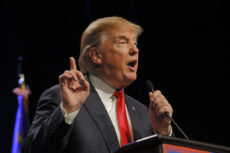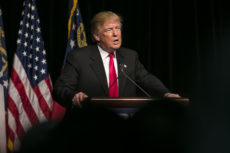Samuel R. Staley • Monday, August 1, 2016 •
 Hollywood’s rediscovery of freedom is cropping up in interesting places more and more. I’ve discussed themes emphasizing individual responsibility and skepticism about government in films such as Captain America: Civil War, the Divergent trilogy, and other media, but these ideas might have real staying power if what I just saw in Jason Bourne, the Matt Damon vehicle based on the Robert Ludlum novels, is an indicator. The danger of government infringement on privacy rights through mass surveillance is central to the film’s story as well as society and the tech community more specifically—see the new Independent Institute book, American Surveillance, by Anthony Gregory on this issue—even though the inclusion of this theme is creatively awkward in the film. In other words, the film’s creators seem to be making a statement.
Hollywood’s rediscovery of freedom is cropping up in interesting places more and more. I’ve discussed themes emphasizing individual responsibility and skepticism about government in films such as Captain America: Civil War, the Divergent trilogy, and other media, but these ideas might have real staying power if what I just saw in Jason Bourne, the Matt Damon vehicle based on the Robert Ludlum novels, is an indicator. The danger of government infringement on privacy rights through mass surveillance is central to the film’s story as well as society and the tech community more specifically—see the new Independent Institute book, American Surveillance, by Anthony Gregory on this issue—even though the inclusion of this theme is creatively awkward in the film. In other words, the film’s creators seem to be making a statement.
On the surface, Jason Bourne is what viewers have come to expect from this franchise—well packaged, tightly packed action films featuring excellent performances by A-list actors such as Damon, Tommy Lee Jones, and Julia Stiles. The plots in the movies tend to be a bit thin, and this film is thinner than most.
After vanquishing the undercover CIA assassination programs Treadstone and Blackbriar, Jason Bourne is off the grid. He earns a living as an underground fighter, dispatching opponents with power and aggression. Bourne is brought back to the surface when Nicky Parsons (Julia Stiles) discovers files linking his father to the founding of Treadstone, the original covert operation, and Jason Bourne’s recruitment into the program. It’s Bourne’s quest for the truth about this familial link, and what it means for his character, that drives the film’s main plot.
Lawrence J. McQuillan • Monday, August 1, 2016 •
 In 2010, California voters approved a “top-two” primary system for congressional and statewide elected positions where primary voters choose among all candidates in all parties for each position. The top two vote getters in the primary, regardless of party affiliation, move on to the general election to face each other. The argument at the time was that this system would produce more “moderate” candidates with more “moderate” policy positions, and increase competition. There is little indication that it has moderated anything. In fact, it has worked to exclude third-, fourth-, and nth-party candidates from the general election.
In 2010, California voters approved a “top-two” primary system for congressional and statewide elected positions where primary voters choose among all candidates in all parties for each position. The top two vote getters in the primary, regardless of party affiliation, move on to the general election to face each other. The argument at the time was that this system would produce more “moderate” candidates with more “moderate” policy positions, and increase competition. There is little indication that it has moderated anything. In fact, it has worked to exclude third-, fourth-, and nth-party candidates from the general election.
Case in point is this November’s U.S. Senate race in California between extreme liberal Democrat Kamala Harris and somewhat less extreme liberal Democrat Loretta Sanchez. No other parties will be represented on the ballot. Harris will win. According to a new poll, half of Republicans and 34 percent of independents in California said they will not vote in this senate race.
Another voting reform, touted as producing more moderate outcomes, is approval voting, where each voter can vote for as many candidates as they wish on the ballot for each elected position. The single winner is the most-approved candidate, the person with the most total votes. The idea dates back to 1977 when Guy Ottewell first described the approach. In 1978, a couple smart guys, political scientist Steven Brams and mathematician Peter Fishburn, fully developed the concept in the American Political Science Review. More smart guys are promoting approval voting at the Center for Election Science (CES).
Randall G. Holcombe • Monday, August 1, 2016 •
 This article explains that a Federal Appeals Court recently struck down a requirement that voters in North Carolina must show a photo ID to vote. I realize that this is a partisan issue and I’m not trying to make a partisan argument. I’m just wondering when it is reasonable to be required to show a photo ID.
This article explains that a Federal Appeals Court recently struck down a requirement that voters in North Carolina must show a photo ID to vote. I realize that this is a partisan issue and I’m not trying to make a partisan argument. I’m just wondering when it is reasonable to be required to show a photo ID.
If I’m driving a car, the law requires that I carry my driver’s license and present it when asked by law enforcement personnel. Why should I need to present a photo ID to drive a car, when I don’t need one to vote?
One answer might be that voting, unlike driving, is a right protected by the Constitution. But then, so is the right to bear arms. But if I want to carry a gun, my state requires that I also must carry a concealed weapons permit, a photo ID. Why do I need a photo ID to exercise my constitutional right to bear arms but not my constitutional right to vote?
(Note that this varies from state to state. Why do I not have the same constitutional rights in one state as another? I live in Florida, where concealed carry is allowed for people who have a permit, but open carry is prohibited even to those with permits.)
The court’s rationale was that their ruling addresses the legacy of racial discrimination in North Carolina. But in that case, requiring a concealed carry permit to exercise one’s Second Amendment rights would appear to be even more discriminatory. First, there is the cost of acquiring the permit, which places a disproportionate burden on the poor. Second, a disproportionate number of blacks have felony convictions, often for victimless “crimes” like drug use, which bars them from getting a permit. The requirement to have a concealed carry permit seems more discriminatory to me than the requirement to show a photo ID to vote.
I’m an economist, not a legal scholar, so maybe there is some legal rationale I don’t understand. But I can’t figure out why the law would allow people to vote without showing a photo ID, but requires one to drive, or to carry a firearm.
Anthony Gregory • Friday, July 29, 2016 •
Editor: Today is the publication date of the Independent Institute’s newest book, American Surveillance: Intelligence, Privacy, and the Fourth Amendment, by Anthony Gregory (Research Fellow, Independent Institute). Published for Independent by the University of Wisconsin Press, this widely acclaimed new book traces the history of government surveillance in the U.S. that transcends party divides, urging us to look deeper into government policy and how best to protect individual privacy.
*******************
Whatever else it might be, November’s election won’t be a referendum on surveillance and privacy. Hillary Rodham Clinton voted as Senator for the USA PATRIOT Act in 2001 and 2006, and Donald Trump has approved its renewal, saying he tends to “err on the side of security.” In the Democratic debates, Clinton harshly criticized NSA whistleblower Edward Snowden, insisting, probably wrongly, that he “could have gotten all of the protections of being a whistleblower” and “raised all the issues” without breaking the law. Trump has called Snowden a traitor, promised to get Russian president Vladimir Putin to hand him over, and in the past even suggested him worthy of execution. Both candidates want to expand foreign intelligence. Clinton recently told Fox television host Bill O’Reilly that among her “priorities is to launch an intelligence surge” and more information-sharing to combat terror. Trump told CBS journalist Leslie Stahl that, to defeat ISIS, “we’re going to have unbelievable intelligence, which we need [and] right now, we don’t have.”
Both major political parties have nominated surveillance hawks for the highest office in 2016, but we could excuse the public for discerning partisan differences. In recent years, both sides have postured as disagreeing fundamentally. Barack Obama ran for president echoing fellow Democrats’ condemnation of President George W. Bush’s attempts to immunize telecoms implicated in NSA warrantless wiretapping. Under Obama’s presidency, the Republican National Committee denounced the NSA’s “dragnet program” as likely “the largest surveillance effort ever launched by a democratic government against its own citizens” and its mass data collection as “contrary to the right of privacy protected by the Fourth Amendment.” Inconsistent politicians have mirrored a shift among constituents. The Pew Research Center in 2006 found that 37% of Democrats and 75% of Republicans considered Bush’s surveillance program acceptable. In 2013, 64% of Democrats and 52% of Republicans approved NSA surveillance under Obama.
John R. Graham • Friday, July 29, 2016 •
 The Democratic National Convention has produced a 51-page campaign platform that devotes five pages to health care. Leaving aside the promotion of abortion as a partisan wedge issue, the platform asserts the goal of “universal health care,” which is “a right, not a privilege.”
The Democratic National Convention has produced a 51-page campaign platform that devotes five pages to health care. Leaving aside the promotion of abortion as a partisan wedge issue, the platform asserts the goal of “universal health care,” which is “a right, not a privilege.”
The notion of health care as a “right” is now widespread, although a banal platitude has dangerous implications. Whenever I am asked whether a person has a “right to health care,” I answer: “A person has the right to spend as much of his money on health care of his choice as he prefers.” This generally results in confused looks. I then describe how that right is infringed by Medicare payroll taxes, and government programs like Medicaid, the Veterans Health Administration, and Children’s Health Insurance Program. Taxes funding those programs are taken from people’s incomes, and cannot therefore be spent on health care which the earners prefer.
A “right” to health care is likely more dangerous than a right to food (which can result in severe shortages due to government confiscation and distribution). If worse comes to worst, at least you might be able to keep some chickens and grow some fruit and vegetables on your own plot of land. Modern health care, on the other hand, requires highly skilled practitioners and capital investment in medical innovation. Suppliers of both can go on strike in response to government control, and the ordinary person can hardly perform his own knee replacement or make his own hypertensive drug.
John R. Graham • Friday, July 29, 2016 •
 Writing in the Wall Street Journal, economics professor Shirley Svorny of California State University, Northridge, and the Cato Institute argues that Congress should use the power granted by the U.S. Constitution’s Commerce Clause to pre-empt states’ historical power to regulate physicians’ scope of practice:
Writing in the Wall Street Journal, economics professor Shirley Svorny of California State University, Northridge, and the Cato Institute argues that Congress should use the power granted by the U.S. Constitution’s Commerce Clause to pre-empt states’ historical power to regulate physicians’ scope of practice:
Telemedicine has made exciting advances in recent years. Remote access to experts lets patients in stroke, neonatal and intensive-care units get better treatment at a lower cost than ever before. In rural communities, the technology improves timely access to care and reduces expensive medevac trips. Remote-monitoring technology lets patients with chronic conditions live at home rather than in an assisted-living facility.
Yet while telemedicine can connect a patient in rural Idaho with top specialists in New York, it often runs into a brick wall at state lines. Instead of welcoming the benefits of telemedicine, state governments and entrenched interests use licensing laws to make it difficult for out-of-state experts to offer remote care.
(S. Svorny, “Telemedicine Runs Into Crony Doctoring,” Wall Street Journal, July 22, 2016)
Professor Svorny urges Congress to pass a law allowing interstate portability of licensure. The state where a physician practices, not where the patient stands (or sits or lies), would be the locus of regulatory control. That is, Idaho would lose its sovereign power to prevent New York-licensed physicians from providing telemedicine services to Idaho patients.
Abigail R. Hall • Friday, July 29, 2016 •
 I was recently asked to give a talk for the Foundation for Economic Education (FEE) on how we can improve society. Now, I’ve been asked to give my fair share of presentations. Most are things that fit nicely into the economist’s “wheelhouse.” Ask me to explain public choice, price controls, the economics of war, terrorism, drugs, etc. and I’m ready to go.
I was recently asked to give a talk for the Foundation for Economic Education (FEE) on how we can improve society. Now, I’ve been asked to give my fair share of presentations. Most are things that fit nicely into the economist’s “wheelhouse.” Ask me to explain public choice, price controls, the economics of war, terrorism, drugs, etc. and I’m ready to go.
But this talk provided a challenge.
As an economist, I see my job as discussing patterns in society, using theory to explain general tendencies and directions. This is in contrast to point predictions, or making suggestions on specific things to do in particular magnitudes. To offer advice on such an important topic of “how do we improve society” seemed a task outside what economists (or anyone for that matter) are capable and qualified to answer. So after racking my brain, I did what I sometimes do when I’m stuck and asked the all-powerful entity known as “Facebook.” After gathering thoughts from friends and colleagues and collecting my own thoughts, I offered students the following (and a few others).
- Engage Ideas
John R. Graham • Thursday, July 28, 2016 •
 Arkansas has a love-hate relationship with Obamacare. The previous (Democratic) governor, Mike Beebe, made a deal to accept Obamacare’s Medicaid expansion but with an interesting twist. Obamacare significantly increased the number of Americans who could become dependent on Medicaid by increasing the income cut-off for eligibility. Many governors rejected the federal funds offered to expand this welfare dependency.
Arkansas has a love-hate relationship with Obamacare. The previous (Democratic) governor, Mike Beebe, made a deal to accept Obamacare’s Medicaid expansion but with an interesting twist. Obamacare significantly increased the number of Americans who could become dependent on Medicaid by increasing the income cut-off for eligibility. Many governors rejected the federal funds offered to expand this welfare dependency.
Governor Beebe took the money, but instead of using it to expand Medicaid for the newly eligible, he used it to subsidize beneficiaries’ purchase of private plans in Obamacare’s health insurance exchange. His successor, Republican Asa Hutchinson, and the Republican-majority legislature, decided to continue the program.
According to new research published by the University of Pennsylvania, this “private option” yielded dramatically improved access to care. In a “secret shopper” survey, callers identifying themselves as dependents on traditional Medicaid were able to make appointments with primary-care physicians in 55.5 percent of attempts. Medicaid dependents enrolled in exchange plans got appointments 83.2 percent of the time.
That is good news. Traditional Medicaid offers poor access to care because it does not pay physicians enough to see patients. The exchange plans pay more, so enrollees were able to get care. On the other hand, they cost more. According to the Government Accountability Office, the “private option” will cost an extra $778 million over three years. With 200,000 enrollees, that amounts to an extra $1,297 per person per year.
That is a lot of money. Maybe Arkansas and the federal government could think of another option. These appointments are for primary care. Why do we need insurers or a Medicaid bureaucracy in the middle? How about just giving a sum of money to the patients and allowing them to pay primary-care doctors directly?
* * *
For the pivotal alternative to Obamacare, see the Independent Institute’s widely acclaimed book, Priceless: Curing the Healthcare Crisis, by John C. Goodman.
Abigail R. Hall • Thursday, July 28, 2016 •
 A few months back, I wrote on Donald Trump’s run for the White House and his economic policies. At the time, I noted that, love him or hate him, he’d gone farther than pretty much anyone had anticipated.
A few months back, I wrote on Donald Trump’s run for the White House and his economic policies. At the time, I noted that, love him or hate him, he’d gone farther than pretty much anyone had anticipated.
I have to admit that I was surprised that Trump secured the Republican nomination for the Presidency, but the Republican National Convention last week left no more room for doubt. Trump is the GOP nominee.
Several people asked me what I thought of the RNC. Until the last night, I was honestly able to respond with, “I haven’t watched, but hear it’s been a show.” Alas, on the final night of the convention, my husband turned on the TV as Mr. Trump was speaking. What I heard him say made me both remarkably sad and incredibly angry.
Randall G. Holcombe • Thursday, July 28, 2016 •
 Donald Trump’s acceptance speech at the Republican National Convention was a list of aspirations, without any explanation of the policies he had in mind to meet those goals. That’s not surprising, because that is the nature of political campaign rhetoric. Politicians rarely say what they plan to do. Rather, they talk about perceived problems that exist now, and say they will make things better. This isn’t a criticism of Trump. All politicians do that, and I fully expect Hillary Clinton’s acceptance speech to be much the same.
Donald Trump’s acceptance speech at the Republican National Convention was a list of aspirations, without any explanation of the policies he had in mind to meet those goals. That’s not surprising, because that is the nature of political campaign rhetoric. Politicians rarely say what they plan to do. Rather, they talk about perceived problems that exist now, and say they will make things better. This isn’t a criticism of Trump. All politicians do that, and I fully expect Hillary Clinton’s acceptance speech to be much the same.
Trump said he would make America safe again. He didn’t say how. He said he’d hire the best people to get the job done, but he didn’t say who they are, or how he would find them.
Trump said we had bad trade deals, and he’d renegotiate them to get better deals. He didn’t say what was wrong with the deals we have, and he didn’t say what terms he’d include in any renegotiated deals.
 Hollywood’s rediscovery of freedom is cropping up in interesting places more and more. I’ve discussed themes emphasizing individual responsibility and skepticism about government in films such as Captain America: Civil War, the Divergent trilogy, and other media, but these ideas might have real staying power if what I just saw in Jason Bourne, the Matt Damon vehicle based on the Robert Ludlum novels, is an indicator. The danger of government infringement on privacy rights through mass surveillance is central to the film’s story as well as society and the tech community more specifically—see the new Independent Institute book, American Surveillance, by Anthony Gregory on this issue—even though the inclusion of this theme is creatively awkward in the film. In other words, the film’s creators seem to be making a statement.
Hollywood’s rediscovery of freedom is cropping up in interesting places more and more. I’ve discussed themes emphasizing individual responsibility and skepticism about government in films such as Captain America: Civil War, the Divergent trilogy, and other media, but these ideas might have real staying power if what I just saw in Jason Bourne, the Matt Damon vehicle based on the Robert Ludlum novels, is an indicator. The danger of government infringement on privacy rights through mass surveillance is central to the film’s story as well as society and the tech community more specifically—see the new Independent Institute book, American Surveillance, by Anthony Gregory on this issue—even though the inclusion of this theme is creatively awkward in the film. In other words, the film’s creators seem to be making a statement. In 2010, California voters approved a “top-two” primary system for congressional and statewide elected positions where primary voters choose among all candidates in all parties for each position. The top two vote getters in the primary, regardless of party affiliation, move on to the general election to face each other. The argument at the time was that this system would produce more “moderate” candidates with more “moderate” policy positions, and increase competition. There is little indication that it has moderated anything. In fact, it has worked to exclude third-, fourth-, and nth-party candidates from the general election.
In 2010, California voters approved a “top-two” primary system for congressional and statewide elected positions where primary voters choose among all candidates in all parties for each position. The top two vote getters in the primary, regardless of party affiliation, move on to the general election to face each other. The argument at the time was that this system would produce more “moderate” candidates with more “moderate” policy positions, and increase competition. There is little indication that it has moderated anything. In fact, it has worked to exclude third-, fourth-, and nth-party candidates from the general election. This article
This article The Democratic National Convention has produced a
The Democratic National Convention has produced a  Writing in the Wall Street Journal, economics professor
Writing in the Wall Street Journal, economics professor  I was recently asked to give a talk for the
I was recently asked to give a talk for the  Arkansas has a love-hate relationship with Obamacare. The previous (Democratic) governor, Mike Beebe, made a deal to accept Obamacare’s Medicaid expansion but with an interesting twist. Obamacare significantly increased the number of Americans who could become dependent on Medicaid by increasing the income cut-off for eligibility. Many governors rejected the federal funds offered to expand this welfare dependency.
Arkansas has a love-hate relationship with Obamacare. The previous (Democratic) governor, Mike Beebe, made a deal to accept Obamacare’s Medicaid expansion but with an interesting twist. Obamacare significantly increased the number of Americans who could become dependent on Medicaid by increasing the income cut-off for eligibility. Many governors rejected the federal funds offered to expand this welfare dependency. A few months back, I
A few months back, I Donald Trump’s acceptance speech at the Republican National Convention was a list of aspirations, without any explanation of the policies he had in mind to meet those goals. That’s not surprising, because that is the nature of political campaign rhetoric. Politicians rarely say what they plan to do. Rather, they talk about perceived problems that exist now, and say they will make things better. This isn’t a criticism of Trump. All politicians do that, and I fully expect Hillary Clinton’s acceptance speech to be much the same.
Donald Trump’s acceptance speech at the Republican National Convention was a list of aspirations, without any explanation of the policies he had in mind to meet those goals. That’s not surprising, because that is the nature of political campaign rhetoric. Politicians rarely say what they plan to do. Rather, they talk about perceived problems that exist now, and say they will make things better. This isn’t a criticism of Trump. All politicians do that, and I fully expect Hillary Clinton’s acceptance speech to be much the same.




